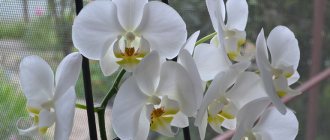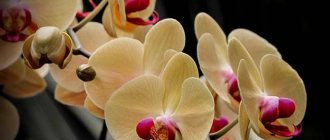Hybrid phalaenopsis
Phalaenopsis belongs to the orchid family. This type of orchid was first discovered in 1825 on the islands of the Malay archipelago. After that, these unusual plants of different species were found in the territory of Southeast Indonesia and the tropical region of Australia. They gave rise to many hybrids and varieties of phalaenopsis.
Standard
The first phalaenopsis hybrids had large white or pink flowers and tall peduncles. They are called standard. Further interspecific selection continued in various directions:
- breeding plants with large flowers;
- brightly colored or variegated petals;
- miniature phalaenopsis, etc.
Example of hybrid Maki Watanabe 'Kingfisher Orchids' (Romance Miki X Otohime)
Mini
In the middle of the last century, miniature phalaenopsis came into fashion. This is a fairly large group of varieties that share common characteristics:
- small flower-bearing arrow;
- small classically shaped flowers.
Phalaenopsis mini. Size relative to lighter size.
Taiwanese
Nowadays, Singapore is a trendsetter in the field of orchid breeding, resulting in plants with pure petals of bright colors or spotted patterns , for which they were called “harlequins”.
Taiwanese Phalaenopsis Harlequin.
Novelty
These hybrids include plants with non-dying peduncles . After flowering, they enter a dormant period, after which old flower stalks simultaneously grow and new ones form.
An adult novelty can have several dozen inflorescences that bloom up to 5 times a year. The petals of small flowers are covered with a tiger or leopard pattern, ripples or dots of different sizes.
Novelty I-Hsin Salmon Copper Star.
Pelorics
Phalaenopsis pelorica is of particular interest to orchid collectors. Peloric is a plant that has undergone a mutation, as a result of which its flowers have an atypical shape for its variety, and the petals and sepals take on the shape of a flower lip , which gives the flower an unusual appearance.
Philadelphia Peloric.
Primary
The selection of numerous varieties and hybrids of phalaenopsis began with interspecific hybridization:
- The first Phalaenopsis hybrid was obtained in 1875 by John Seden as a result of the hybridization of Phal. aphrodite and Phal. equestris. And by 1900 there were already thirteen such hybrids;
- an unusual hybrid was obtained in 1940 and registered under the name Phal.Doris. It is characterized by multi-flowered peduncles and huge, pure white flowers of a flattened shape, about 14 cm in diameter;
- A striking representative of miniature hybrid phalaenopsis is Phal. Mini Mark "Maria Teresa" , reaching a height of 25 cm. A large number of branched peduncles are strewn with small flowers with an ivory color , dotted with tiny red-yellow spots;
- spotted hybrid phalaenopsis is represented by phalaenopsis of French selection and Taiwanese “harlequins”. One of the common varieties is Phal. "Paradise" , an exquisite variety with medium-sized flowers and elongated petals light greenish-yellow shade, dotted with pink-brown speckles.
Phalaenopsis Krabi Paradise.
Interesting! Currently, more than 5 thousand phalaenopsis hybrids have been registered.
Intergeneric
A further impetus for obtaining new forms and colors of phalaenopsis was their hybridization with related genera of orchids:
- Doritis;
- Renanthera;
- Ascocentrum;
- Rhynchostylis et al.
The first intergeneric hybrid called Doritaenopsis with an unusual scarlet color of flowers was obtained in 1923 as a result of crossing a phalaenopsis with an orchid of the genus Doritis. Further selection led to the creation of flowers of other, more complex shades: purple, orange, etc.
Often these orchids are confused, selling one variety after another. But both their appearance and the conditions of their maintenance are identical.
Doritaenopsis Liu's Sakura caused particular delight . Its exquisitely shaped flowers with pinkish pearlescent petals give the inflorescence an amazing delicacy.
Doritaenopsis Liu's Sakura.
The best intergeneric hybrids of modern breeding are blue orchids of the Doritaenopsis Siam Treasure “Blue” variety, Doritaenopsis Kenneth Schubert “Blue Angel”.
Doritaenopsis Siam Treasure 'Blue'.
Doritaenopsis Kenneth Schubert "Blue Angel".
The secret of the name
The genus Phalaenopsis belongs to the epiphytic plants of the Orchidaceae family. The plant is native to the plains and forests of Southeast Asia, the Philippines and northeastern Australia. The characteristic structure of plants belonging to this genus includes:
- Long vertical stem.
- Several large fleshy leaves arranged in two rows.
- Large velvety flowers, similar to exotic butterflies.
Thanks to these flowers, phalaenopsis got its name, since in translation from Greek phalania means “night butterfly” and opsis means “resemblance.”
In nature and special nurseries, there are about 70 species and a huge number of hybrid varieties of phalaenopsis orchids.
Maximum and minimum external characteristics
Orchid hybrids amaze with their huge variety of appearance, from the size of the leaves to the size of the flowers:
- To one of the largest phalaenopsis hybrids can be attributed to the winner of the International Orchid Exhibition of 1933 - Phal. gigantea "Laurie Weltz" It had 7 flowering shoots, 138 flowers and 82 buds. An adult orchid has 4 pairs of leaves reaching a length of 1 m and a flower raceme up to 65 cm long with flowers up to 6.5 cm in diameter;
Phalaenopsis Gigantea in its natural environment. - one of the smallest hybrids is Phal. Mini Mark "Maria Teresa" , reaches a height of no more than 25 cm, has 2-3 pairs of leaves up to 20 cm long and a large number of branched peduncles strewn with small, up to 3 cm in diameter, ivory-colored flowers with tiny red-yellow specks.
Phalaenopsis Mini Mark "Maria Teresa".
How to determine the type of flower?
Under the generic name you can find plants that are completely different from each other: this name can be worn by either a thin tall stem with a pair of graceful flowers on top, or a lush garland studded with velvety “moths”. The following features will help you distinguish between types and varieties:
- Phalaenopsis are divided into two types according to height: ordinary, whose height is a meter, and miniature, whose dimensions do not exceed 30 cm.
- The color of flowers and even the color of leaves varies from species to species; hybrid varieties allow you to achieve incredible shades inherent in a particular species.
- The number of flowers on one peduncle.
- Some varieties emit pleasant, delicate aromas more intensely than others.
- The shape of a flower is one of the most revealing elements. Flowers have a different number of petals, and their location at the tip of the peduncle is also different.
Exotic colors
These colors include blue and black phalaenopsis, which have been very popular in recent years:
- Blue coloration is extremely rare in phalaenopsis. Natural species of blue phalaenopsis have small whitish-blue or pink-blue flowers. They stubbornly pass this color on to their hybrids;
Phalaenopsis Vanda.
- Black Orchid. In nature, there are no plants with black flowers, which is due to their lack of such pigment. All Phalaenopsis hybrids that are tinged with black are actually a deep violet or purple color.
Phalaenopsis Black Butterfly.
Flower colors
To determine the name of a varietal orchid of the genus Phalaenopsis by the appearance of a living flower or from a photo, it is worth focusing on the color of the flowers. Shades vary over a very wide range:
- Single color (white, red, yellow, purple, lilac, pink, lilac). Read about the mythical blue shade of phalaenopsis here.
- Multicolor (flowers with stripes, specks, veins, two-color petals).
A beautiful combination is the contrast between the shades of all the petals and the lip of the flower.
Main features of flowering
Each phalaenopsis hybrid has its own flowering characteristics.
Duration
The duration and frequency of flowering for each hybrid is individual and is directly dependent on the growing conditions. An orchid usually blooms 2-3 times a year; the flowering period can last from several weeks to several months.
Start
Depending on the conditions of detention, a hybrid orchid first blooms at the age of 1.5 to 3 years , when the plant has formed 5 - 8 leaves. If it blooms earlier, then there may not be enough strength for this and the flower will wither.
Transfer
An orchid cannot be replanted during the flowering period, since it will have to spend a lot of energy on flowering and rooting at the same time, and this can lead to serious consequences. It is best to replant the plant immediately after flowering. This happens mainly in spring or autumn.
Note! The flower needs to change the substrate and pot size every 3 years.
In order for the orchid to successfully grow and develop further, you must follow the step-by-step instructions for replanting:
- First, the orchid needs to be removed from the pot. If you can’t pull out the flower, you can crush the pot or even cut it.
- The roots need to be freed from the old bark; if any piece has grown to the flower, then it’s not a big deal.
- It is imperative to remove rotten or dead roots, but it is better not to touch the healthy part.
- Before planting, the flower must be dried. This process takes on average 2 hours.
- Phalaenopsis is planted in the soil and not watered for 5 days. Also, it is not recommended to apply fertilizing during the first month.
Transfer
Landing
Due to the fact that hybrid phalaenopsis are unpretentious to home conditions, if simple rules are followed, they grow well and bloom regularly.
Priming
Soil for orchids is sold at any flower shop, but you can prepare it yourself.
The most common substrate for orchids is pine bark , removed from dead wood or a cut tree. It is mixed with charcoal, perlite (foam granules) and a moisture-intensive component - sphagnum moss .
Before planting phalaenopsis, the substrate is slightly moistened.
Optimal capacity
An orchid is an epiphytic plant, so it needs a pot rather to support the plant and as a stand:
- The ideal container for pholenopsis is a translucent flowerpot made of plastic or glass . In it, the roots will not be able to grow into smooth walls, and the transparent material will provide them with enough light;
- the flowerpot must have drainage holes through which excess water will drain;
- The size of the container is selected according to the volume of the roots: they should fit tightly into the flowerpot.
A properly selected container will ensure healthy growth and rapid development of the orchid.
Peculiarities
The best time to transplant an orchid is spring; at this time, it usually does not bloom . When preparing a plant for transplantation, you must adhere to the following rules:
- Expanded clay is placed at the bottom of the flowerpot to a height of 1/4 of the volume to protect the roots from rotting;
- the plant is soaked in water to make it easier to remove from the flowerpot;
- clean the roots from the substrate;
- rotten roots are removed down to living tissue, the cut site is covered with crushed activated carbon;
- The roots are washed in water and allowed to dry for about 15 minutes.
When planting, the roots of the orchid are lowered into the pot, at the same time the prepared substrate is added and lightly shaken to evenly distribute the soil.
Phalaenopsis transplant.
Important! Try to leave the roots that grew above the surface of the pot open.
With proper transplantation, you can expect phalaenopsis to bloom within a year.
Care
Caring for phalaenopsis hybrids is not particularly difficult even for novice hobbyists.
Optimal conditions of detention
Unlike most natural types of orchids, phalaenopsis hybrids are not particularly demanding on room lighting, humidity and temperature:
- they can even grow on a north-facing window; they love diffused sunlight;
- feel comfortable in the temperature range from 10 to 28℃. At temperatures above 30℃, the plant is provided with ventilation;
- do not need pallets or expanded clay to create additional humidity.
If the air humidity is sufficient, the long green part of the roots is visible.
Replanting after shopping in a store
After purchasing a phalaenopsis, the plant does not need to be replanted. The first thing to do is to provide the orchid with a two-week quarantine , placing it separately from other plants:
- choose a slightly shaded place where direct sunlight does not penetrate;
- During quarantine, it is not recommended to water or feed the orchid with fertilizers.
After quarantine, the plant is exposed to diffused light and watered little by little.
Flowering time and dormant period at home
Under optimal conditions of maintenance and care, phalaenopsis blooms 2-3 times a year , after which it enters a resting phase.
Its duration depends mainly on the physiological state of the plant and usually lasts several months.
Watering and fertilizing
Despite the variety of hybrids and varieties of phalaenopsis, caring for them is practically the same:
- water the orchid only after the substrate has completely dried: the pot with the plant is immersed 1/3 in a container of water, kept for 20-30 minutes;
- Feeding the orchid is necessary only during the active growth of leaves, peduncles and bud formation.
Important! The period of active growth of an orchid does not necessarily occur in spring or summer. Some phalaenopsis hybrids do not have a pronounced dormant period.
Stimulating flowering
Phalaenopsis usually blooms after several months of dormancy. If flowering does not occur for a long time, stimulation of peduncle forcing is carried out:
- reduce watering to once a week and create a daily temperature difference of 5-8℃.
As a rule, after a couple of months the plant forms a peduncle.
Pruning after flowering
The most suitable time for pruning an orchid is the dormant period, when the plant has completely faded and buds no longer form on the shoot . When is the best time to do this, depends on the type of orchid and the condition of the flower arrow:
- the green peduncle is not cut off; new flowers or babies often form on it;
- if the arrow of the peduncle has turned brown and dried out, remove it;
- when the peduncle has partially dried, it is cut back to living tissue.
Pruning diagram after flowering.
Attention! Proper pruning of phalaenopsis is a guarantee of its well-being and regular flowering.
Prevention of diseases and pests
The best disease prevention is creating optimal conditions and proper plant care . This maintains the plant’s immunity at a high level, preventing infection by pests and microorganisms.
Popular types and varieties with photos
Phalaenopsis are ideal plants for home cultivation, which perfectly adapt to the microclimate of apartments and private houses. Although such varieties require tropical humidity and temperature, they are unpretentious compared to their wild relatives. Natural types of orchids can only be grown in greenhouses, while “domesticated” plants feel great on a windowsill.
Phalaenopsis Amabilis or Amabilis
Phalaenopsis Pleasant
This variety of phalaenopsis is actively used for crossing and obtaining new varieties, as it has excellent characteristics. The plant boasts large (up to 10 cm) flowers and abundant budding.
On average, an Amabilis rosette consists of 4-8 dark green leaves, arranged in two rows. The plates themselves are fleshy, oblong, their width does not exceed 12 cm, and their length varies between 35-50 cm. The buds are formed on long (about 1.5 m) peduncles, which take on a gracefully curved shape. Up to 20 flowers bloom on one stem with a delicate and pleasant aroma. The color of the lip can be different; there are specimens with pink, snow-white and yellow shades.
Phalaenopsis Pleasant easily forms replacement peduncles - for this you need to prune 1-2 cm above the node of the lower branch. The budding period is long, most often occurring from October to March.
Phalaenopsis Shilleriana
Phalaenopsis Schiller's
Orchid Schilleriana is similar to Amabilis and is also actively used for hybridization, being the ancestors of many modern varieties. The main difference between these species is the foliage - in Phalaenopsis Schiller it is variegated. The plates have a distinct marble pattern, formed by alternating silver and dark green transverse stripes. The appearance of the roots is also different from the usual - the shoots are not round, but flat.
Schiller is considered a large orchid, because in natural habitats, adult specimens grow leaves about 50 cm long, while the width does not exceed 8-10 cm. When grown indoors, phalaenopsis rarely becomes a giant, keeping the green mass within 25 cm of length.
During flowering, Schiller looks very impressive, forming a long peduncle with many buds (about 170 in the wild), which remain fresh for a long time. For long and abundant flowering, it is necessary to maintain a stable daylight hours and temperature within +18-+20 degrees.
The color range of the petals varies from light pink to burgundy, while reddish dots can be seen at the base of the lateral sepals. As they ripen (approximately the second week of flowering), the buds thin out a pleasant aroma, similar to the smell of a rose.
Phalaenopsis stuartiana
Phalaenopsis Stuart
Phalaenopsis Stuart is another variegated plant of the orchid world, native to the island of Mandanao. On the outer side of the dark green leaf blades, silver-gray rounded spots are noticeable, which form a marble pattern. As a rule, variegation disappears with age. The foliage below is dark purple, making the rosette look quite impressive.
Stuart can boast of a strong root system that develops well in any conditions. Flat grayish roots at the ends acquire an olive tint. The stem of phalaenopsis is short, therefore it is completely covered with leaves, the number of which varies from 2 to 6 depending on the age of the plant.
A branched, hanging peduncle is formed at the base of the stem and reaches 80-90 cm in length. Several dozen buds are formed on it, opening almost simultaneously. The diameter of the flower does not exceed 7 cm, but the small size is fully compensated by the abundant budding. Phalaenopsis Stewart is a fragrant orchid, but the smell is weak.
The orchid's petals are white, but the lateral sepals are always yellowish and have reddish dots. The lip changes color from golden to purple towards the base of the flower. The average lifespan of a fully blossomed bud does not exceed 25-30 days, however, in favorable conditions, the intervals between flowerings are short.
Phalaenopsis Sanderiana
Phalaenopsis Sander
Sander is a rare and expensive orchid that is valued for the unique beauty of the flower. The foliage is variegated, with a “tiger” color, which is formed by alternating light and dark green stripes. Mature plants grow thick oval leaves 15-40 cm long and 10-15 cm wide, the average length of the peduncle is 80 cm.
The buds on drooping peduncles are arranged oppositely, their number can reach 50-60 pieces. The diameter of the flower varies between 5-8 cm. The color of the petals is varied - there are shades from whitish to rich pink and purple. The lip is also characterized by variable shades - white, yellowish, light brown, splashes of red are often noticeable.
Phalaenopsis Lueddemanniana
Phalaenopsis Luddeman
A medium-sized fragrant orchid from the tropical forests of the Philippines, it was named after the French breeder F. Luddeman, who achieved its cultivated flowering in 1865. The stem of phalaenopsis is hidden by leaves, the number of which can vary from 5 to 8 for different specimens.
The oblong leaf plates are located opposite, their width does not exceed 5-10 cm, and the length varies between 10-25 cm. A drooping peduncle is formed at the base of the stem, growing up to 35 cm. From 2 to 7 buds are formed on it, which bloom alternately , keeping fresh for a month.
Luddeman's flowers are small, only 3-7 cm in diameter, but they look quite unusual, distinguishing the orchid from other varieties of phalaenopsis. The waxy petals are smaller than the sepals and have sharp tips, due to which the open bud takes on a star-shaped shape. The color of the flower is characteristic - transverse stripes of violet, purple or brown form an interesting pattern. The small whitish lip is noticeable against the background of the petals due to its bright purple bloom and yellowish dots.
Giant Phalaenopsis (Phalaenopsis Gigantea)
Phalaenopsis giant
Phalaenopsis giant is the largest representative of the genus, the size of which is amazing not only in person, but also in the photo. Just look at the foliage, the length of which reaches 1 meter and a width of 40 cm! The plates of the gigantea hang down, completely hiding the stem. The surface of the leaves is shiny on both sides and leathery.
Phalaenopsis giant
The peduncle of a giant orchid gracefully hangs down, forming entire clusters of inflorescences. The diameter of a fully open, round shaped bud does not exceed 3-7 cm. The plant emits a pleasant citrus aroma. The color of the petals is variable - you can see flowers of milky cream, yellow-green and other shades, often there are reddish spots or streaks.
Gigantea grows slowly, flowering occurs in 6-12 years, however, in optimal conditions and if all growing rules are followed, you can see the first buds after 5 years. The plant easily crosses with beautifully flowering orchid species, and is therefore actively used for hybridization.
Pink Phalaenopsis (Phalaenopsis Rosea)
Phalaenopsis pink
Phalaenopsis pink is a compact representative of the genus that will fit on any windowsill. The main advantages of this variety are its small size and lush flowering.
The leaves of the orchid are oblong and oval, the length reaches 14 cm, and the width does not exceed 8 cm. The peduncle is short, only 20 cm, but it bears up to 15 small flowers. The color of the petals is pale pink with a pattern of purple veins. The small lip of a rich pink color has three lobes, the tip of the anther is elongated.
For long-term flowering of pink phalaenopsis, it is important to maintain consistently high humidity and temperature, bringing conditions closer to natural ones.
Phalaenopsis cornu-cervi
Phalaenopsis staghorn
Phalaenopsis staghorn received its name due to the unusual appearance of the flower, the shape of which visually resembles deer antlers - this can even be seen in the photo. The peduncle of an orchid is perennial, long-lived and flat, its length does not exceed 20-45 cm, the maximum number of buds is 12. Comb-like growths are formed in place of flower buds.
The flowers of deer antler are small, up to 5 cm in diameter, and exude a perceptible aroma. The color is golden-red or yellow-green with brown stripes and spots. Budding lasts from May to August.
Phalaenopsis amboinensis
Phalaenopsis Ambonese
A medium-sized orchid when kept indoors grows 4-6 elliptical leaves. The plates reach 14-25 cm in length, while the width is kept within 10 cm. The average height of the peduncle is 45 cm, more often one stem is formed, less often two or three.
The main feature of Ambonese phalaenopsis is its “revolving” flowering - a maximum of 2 buds bloom on the plant at the same time. Upon completion of budding, the peduncle lengthens, forming a new flower bud.
The orchid's petals are variegated, with all segments of the flower being cream, yellow or with a noticeable greenish undertone, abundantly covered with brownish or brick-like strokes. Thanks to the characteristic arrangement of the stripes, the bud acquires a “tiger” color.
Reproduction methods
There are several ways to vegetatively propagate phalaenopsis at home:
- cuttings, for this purpose a faded peduncle is used;
- children that form on the phalaenopsis stem or peduncle after flowering.
This will allow you to grow an exact copy of your orchid yourself.
Propagation of phalaenopsis by cuttings.
Growing problems
Sometimes when growing orchids, gardeners encounter various problems.
The leaves are getting smaller
If phalaenopsis leaves become smaller, then most likely there are problems with the roots:
- perhaps the composition of the substrate is incorrectly selected;
- roots were damaged during transplantation or improper watering.
Such a plant can be placed in a greenhouse or re-rooted.
No flowering
There may be several reasons for this:
- insufficient illumination of the plant;
- the plant is overfed with nitrogen fertilizer;
- waterlogging of the substrate.
Almost all types of orchids begin to bloom at the end of the growing season.











